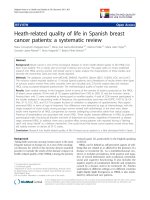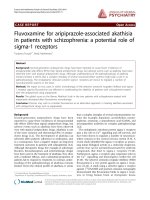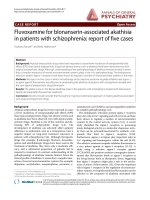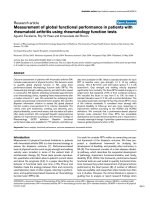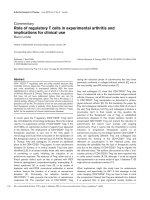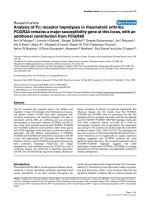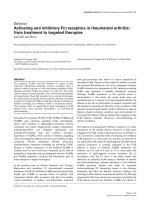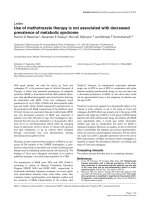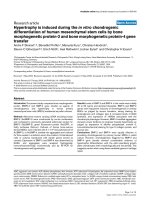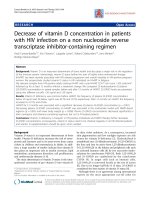Báo cáo y học: "Lower limb biomechanics during running in individuals with achilles tendinopathy: a systematic review" potx
Bạn đang xem bản rút gọn của tài liệu. Xem và tải ngay bản đầy đủ của tài liệu tại đây (5.2 MB, 17 trang )
JOURNAL OF FOOT
AND ANKLE RESEARCH
Lower limb biomechanics during running in
individuals with achilles tendinopathy: a
systematic review
Munteanu and Barton
Munteanu and Barton Journal of Foot and Ankle Research 2011, 4:15
(30 May 2011)
REVIEW Open Access
Lower limb biomechanics during running in
individuals with achilles tendinopathy: a
systematic review
Shannon E Munteanu
1,2*
and Christian J Barton
1,3
Abstract
Background: Abnormal lower limb biomechanics is speculated to be a risk factor for Achilles tendinopathy. This
study systematically reviewed the existin g literature to identify, critique and summarise lo wer limb biomechanical
factors associated with Achilles tendinopathy.
Methods: We searched electronic bibliographic databases (Medline, EMBASE, Current contents, CINAHL and
SPORTDiscus) in November 2010. All prospective cohort and case-control studies that evaluated biomechanical
factors (temporospatial parameters, lower limb kinematics, dynamic plantar pressures, kinetics [ground reaction
forces and joint moments] and muscle activity) associated with mid-portion Ach illes tendinopathy were included.
Quality of included studies was evaluated using the Quality Index. The magnitude of differences (effect sizes)
between cases and controls was calculated using Cohen’s d (with 95% CIs).
Results: Nine studies were identified; two were prospective and the remaining seven case-control study designs.
The quality of 9 identified studies was varied, with Quality Index scores ranging from 4 to 15 out of 17. All studies
analysed running biomechanics. Cases displayed increased eversion range of motion of the rearfoot (d = 0.92 and
0.67 in two studies), reduced maximum lower leg abduction (d = -1.16), reduced ankle joint dorsiflexion velocity (d
= -0.6 2) and reduced knee flexion during gait (d = -0.90). Cases also demonstrated a number of differences in
dynamic plantar pressures (primarily the distribution of the centre of force), ground reaction forces (large effects for
timing variables) and also showed reduced peak tibial external rotation moment (d = -1.29). Cases also displayed
differences in the timing and amplitude of a number of lower limb muscles but many differences were equivocal.
Conclusions: There are differences in lower limb biomechanics between those with and without Achilles
tendinopathy that may have implications for the prevention and management of the condition. However, the
findings need to be interpreted with caution due to the limited quality of a number of the included studies.
Future well-designed prospective studies are required to confirm these findings.
Keywords: Achilles tendon, Tendinopathy, Biomechanics, Risk factor
Background
Achill es tendinopathy is a common musculoskeletal dis-
order that can impair physical function in daily living,
occupation and sporting environments. The prevalence
of Achilles tendinopathy has been reported to be greater
in males [1]. The condition accounts for between 8 and
15% of all injuries in recreational runners [2-4] and has
a cumulative lifetime incidence of approximately 24% in
athletes [5]. Although Achilles tendinopathy is common
in athletes, one-third of patients with chronic A chilles
tendinopathy are not physically active [6]. In some set-
tings, approximately 30% of patients who present with
this condition undergo surgical treatment [6,7].
Achilles tendinopathy is considered a multifactorial
condition, with both extrinsic and intrinsic factors
thought to contribute to its development [8-10]. Pro-
posed extrinsic risk factors include altered weightbearing
surfaces (excessively hard, slippery or uneven) [8,10],
* Correspondence:
1
Musculoskeletal Research Centre, Faculty of Health Sciences, La Trobe
University, Bundoora 3086, Victoria, Australia
Full list of author information is available at the end of the article
Munteanu and Barton Journal of Foot and Ankle Research 2011, 4:15
/>JOURNAL OF FOOT
AND ANKLE RESEARCH
© 2011 Munteanu and Barton; licensee BioMed Central Ltd. This is an Open Access article distributed under the terms of the Creative
Commons Attribution License (http://creativ ecommons.org/licenses/by/2.0), which permits unrestricted use, distribution, and
reproduction in any medium, provided th e original work is properly cited.
inappropriate footwear [8,10,11], training errors [10], use
of specific medications such as f luoroquinolones [12]
and the type of exercise activity (e.g., sports involving
the stretch-shorten cycle such as running or jumping)
[5]. Proposed intrinsic risk fac tors include previous
injury [8], increased age [13], presence of specific
genetic variations such as polymorphisms occurring
within the COL5A1 and tenascin-C genes [14], male
gender [15], increased adiposity and/or metabolic disor-
ders [16,17], pre-existing tendon abnormalities [18], tri-
ceps surae inflexibility [10,19], hormonal status [20-22]
and abnormal lower limb biomechanics [8,10,15,23].
Alterations in lower limb biomechanical characteris-
tics including temporospatial parameters, lower limb
kinematics, dynamic plantar pressures, kinetics (gro und
reaction forces and joint moments) and muscle activity
are frequently associated with Achilles tendinopathy
[8,15,23]. One biomechanical factor commonly consid-
ered to be associated with Achilles tendinopathy is the
presence of excessive foot pronation [8]. Clement et al.
[10] originally proposed that excessive pronation of the
foot may lead to Achilles tendinopathy through two
mechanisms. First, excessive pronation of the foot is
speculated to create greater hindfoot eversion motion,
resulting in excessive forces on the medial aspect of
the tendon and subsequent microtears. Second, abnor-
mal pronation of the foot is thought to lead to asyn-
chronous movement between the foot and ankle
during the stance phase of gait, resulting in a subse-
quent ‘wringing’ effect within the Achilles tendon. This
‘wringing’ effect is theorised t o cause vascular impair-
ment within the tendon and peritendon [10] and ele-
vated tensile stress [24] leading to subsequent
degenerative changes in the Achilles tendon. I n addi-
tion to kinematic theories, altered lower limb muscle
function (timing, amplitude or co-ordination of con-
tractions of the triceps surae) [23-26] and altered
lower limb kinetics [11,24,25,27] have also been specu-
lated to be risk factors for Achilles tendinopathy by
increasing tendon loading.
Several studies have been performed to investigate
the association between abnormal lower limb biome-
chanics and Achilles tendinopathy. Critiquing and
summarising results from these studies is now required
to assist in the development of; (i) preventative strate-
gies, and; (ii) specific and effective management strate-
gies for the condition. However, at present, the
aetiology of Achilles tendinopathy is not clearly under-
stood [8]. Therefore, the aim of the present study was
to perform a systematic review of the existing litera-
ture (prospective cohort and retrospective case-control
studies) to identify, critique a nd summarise lower limb
biomechanical factors associated with Achilles
tendinopathy.
Methods
Inclusion and exclusion criteria
Prospective cohort and case-control studies evaluating
biomechanical factors associated with mid-portion
Achill es tendinopathy (i.e., 2-6 cm proximal to its inser-
tion) were considered for inclusion. The inclusion cri-
teria required participants to be described as having:
midsubstance tendinopathy of the Achilles, Achilles ten-
dinitis, tenosynovitis or tendinos is [28]. Additional terms
such as Achilles tendinopathy, tenopathy, tendinosis,
partial rupture, paratenonitis, tendovaginitis, peritendi-
nitis and achillodynia have also been used to describe
the problems of non-insertional pain associated with the
Achilles tendon so were also used [29]. Measures of
interest were gait characteristics including temporospa-
tial parameters, lower limb kinematics, dynamic plantar
pressures, kinetics (ground reaction forces and joint
moments) and muscle activity.
Unpublished studies, case-series studies, non-pee r-
reviewed publications, intervention studies, studies not
involving humans, reviews, letters, opinion articles, non-
English articles and abstracts were excluded. Studies
which included participants with concomitant injury or
pain from structures other than the mid-portion of the
Achille s tendon (e.g., insertional Achilles tendon pathol-
ogy) or that failed to localise the pathology in the ten-
don were excluded.
Search Strategy
MEDLINE (OVID) (1950-), EMBASE (1988-), CINAHL
(1981-), SPORTDiscus and Current Contents (1993 week
27-) electronic databases were searched in November 2010
(week 3). A generic search strategy was formulated [28,30]
and the results are reported in Additional Data File 1.
Review process
All titles and abstracts found were downloaded into
Endnote version XI (Thomson Reuters, Philadelphia,
PA) giving a set of 2701 citations. The set was cross-
referenced and any duplicates were deleted, leaving a
total of 1575 citations. Each title and abstract was evalu-
ated for potential inclusion by two independent
reviewers (SEM and CJB) using a checklist developed
from the inclusion/exclusion criteria outlined above (see
Additional File 2). If insufficient information was con-
tained in the title and a bstract to make a decision on a
study, it was retained until the full text could be
obtained for evaluation. Any disagreements regarding
studies were resolved by a consensus meeting between
the two reviewers.
Methodological quality assessment
The methodological quality of each included study was
assessed using 16 items (maximum score of 17) of the
Munteanu and Barton Journal of Foot and Ankle Research 2011, 4:15
/>Page 2 of 16
‘Quality Index’ considered relevant for assessing pro-
spective cohort and case-co ntrol study designs (Table 1)
[31]. The original Quality Index scale consisting of 26
items was shown to have high internal consistency (KR-
20 = 0.89), test-retest (r = 0.88) and inter-rater (r =
0.75) reliability and high criterion validity (r ≥ 0.85)
[31]. Two reviewers (SEM and CJB) applied the quality
index to each included study independently, and any
scoring discrepancies were resolved through a consensus
meeting.
Statistical analysis
Inter-rater reliability of each item of the Quality Index
was evaluated using unweighted kappa and percentage
agreement statistics, and the overall score was evaluated
using the in tra-class correlation coefficient (ICC
3,1
) with
corresponding 95% confidence intervals (CIs).
Means and standard deviations for all continuous data
were extracted and effect sizes (Cohen’ s d) (with 95%
CIs) calculated to allow comparison between each
study’s results. To allow visual comparison, effect si zes
were entered into forest plots. Categorical data (e.g. fre-
quency of foot type) was compared between groups
using odds ratios (with 95% CIs) transformed to effect
sizes (with 95% CIs) as described by Chinn et al. [32]
Calculated effect sizes were considered statistically sig-
nificant if their 95% CI did no t cross zero. If inadequate
data were available from original studies to complete
effect size calculations, attempts were made via email to
contact the study’s corresponding author for additional
data.
Sample sizes (limbs analysed), the presence or absence
of symptoms, participant demographics (gender, age,
BMI, mass, height, duration of symptoms and sporting
experience) and biomechanical analysis details were al so
extracted to assist in interpretation of findings.
Results
Following the search, nine studies were deemed appro-
priate for inclusion [2,11,19,24,25,27,33-35]. This
included two prospective cohort [2,19] and seven case-
control study designs [11,24,25,27,33-35]. There were no
disagreements amongst reviewers. One study [33] did
not contain appropriate d ata to complete effect size cal-
culations, meaning data extraction ( effect size calcula-
tions) was performed on a t otal of eight studies
[2,11,19,24,25,27,34,35].
Quality assessment of included studies
All individual items from the Quality Index scale
demonstrated high inter-rater reliability (kappas ≥ 0.57)
with percentage agreement ≥ 77.8% (Table 1). The total
score obtained from the Quality Index scale demon-
strated high inter-rater reliability (ICC
3,1
= 0.98).
Additional data
Additional data required to complete effect size calcula-
tions was provided by Baur et al. [11]. Additionally, Van
Ginckeletal.[2]providedreviseddataforsome
reported variables which were reported erroneously in
their manuscript.
Methodological data to assist interpretation of results
Table 2 shows the samples sizes and population charac-
teristics. Table 3 shows the biomechanical analysis
details of each of the included studies.
Differences in lower limb biomechanics between those
with and without Achilles tendinopathy
Temporospatial gait characteristics
Four [11,24,33,34] studies controlled gait velocity. Of the
remaining five studies [2,19,25,27,35], only one [27]
reported temporospatial data, with effect size calcula-
tions indicating no differences in velocity, stride len gth,
stride time or stride frequency between cases and con-
trols. Additionally, another study [35] reported that no
significant differences in gait velocity were evident
between groups but did not present supporting data.
Lower limb kinematics
Three studies investigated frontal plane rearfoot kine-
matics (Figure 1) [25,34,35]. Those with Achilles tendi-
nopathy displayed greater rearfoot eversion range of
motion when shod (d = 0.92) but not unshod [34] and
greater eversion range of motion of the ankle/rearfoot
(d = 0.67) [35]. Effect size calculations for all other fron-
tal plane rearfoot kinematics comparisons were not sta-
tistically significant.
Four studies investigated tibial segment and ankle
joint kinematics (Figure 2) [24,27,34,35]. Donoghue et
al.[34]showedreducedmaximumlowerlegabduction
(barefoot) in cases (d = -1.16). Ryan et al. [35] showed
reduced maximum ankle dorsiflexion velocity in cases
(d = -0.62). All other tibial segment and ankle kinematic
comparisons were not significantly different between
groups [24,27,34,35].
Three studies performed analyses for kn ee and hip
kinematics (Figure 3) [24,27,34]. Azeve do et al. [27]
reported that the magnitude of knee flexion between
heel strike and midstance was significantly reduced in
cases (d = -0.90). Effect size calculations for all other
knee joint kinematics comparisons were not significantly
different between grou ps [24,27,34 ]. There were no sta-
tistically significant effects for comparisons in sagittal
plane hip kinematics [27].
Plantar pressure parameters
A large number of plantar pressure parameters were
analysed across three studies [2,11,19] (Figures 4 A-D
and 5). A prospective study by Van Ginckel et a l. [2]
showed that those who developed Achilles tendinopathy
Munteanu and Barton Journal of Foot and Ankle Research 2011, 4:15
/>Page 3 of 16
Table 1 Modified Downs and Black Quality Index results, and inter-rater reliability for each item and total score
Prospective
(P) or
retrospective
case-control
(R) study
(1) Clear
aim/
hypothesis
(2)
Outcome
measures
clearly
described
(3) Participant
characteristics
clearly
described
(5)
Confounding
variables
(age, gender,
BMI/height/
weight and
participant
activity
levels)
described
(6) Main
findings
clearly
described
(7)
Measures
of random
variability
provided
(10) Actual
probability
values
reported
(11)
Participants
asked to
participate
representative
of entire
population
(12)
Participants
prepared to
participate
representative
of entire
population
(15)
Blinding
of
outcome
assessor
(16)
Analyses
performed
were
planned
(18)
Appropriate
statistics
(20) Valid
and
reliable
outcome
measures
(21)
Appropriate
case-control
matching
(same
population)
(22)
Participants
recruited
over the
same period
of time
(25)
Adjustment
made for
confounding
factors
Total
Azevedo et
al. [27]
R111 2111U U U11UUU111
Baur et al.
[11]
R110 0000U U U11UUUU4
Donoghue
et al. [34]
R110 11100 0 U11UUU07
Donoghue
et al. [33]
R110 11110 0 U11UUU08
Kaufman et
al. [19]
P111 11111 U 111U11013
McCrory et
al. [25]
R110 1110U U U11UUU18
Ryan et al.
[35]
R101 1111U U U11U1U110
Williams et
al. [24]
R111 2111U U 011UUU111
Van
Ginckel et
al. [2]
P111 21111 U 111U11115
%
agreement
100.0 100.0 100.0 77.8 88.9 88.9 88.9 88.9 88.9 77.8 88.9 88.9 100.0 77.8 100.0 88.9
Reliability 1.00 1.00 1.00 0.63 0.61 0.61 0.77 0.82 0.74 0.57 Uc Uc 1.00 0.63 1.00 0.80 0.98
(0.905-
0.995)
(For items 1-3, 6, 7, 10-12, 15, 16, 18, 20, 21, 22 and 25)-0: No, 1: Yes, U: Unable to determine (which received a score of 0)
(For item 5)-0: No, 1: Partially, 2: Yes
Abbreviations:
Uc; Results not distributed appropriately for this statistic to be calculated.
Munteanu and Barton Journal of Foot and Ankle Research 2011, 4:15
/>Page 4 of 16
Table 2 Sample sizes and population characteristics from each included study
Study Symptomatic
(yes/no)
Sample size (limbs) Gender (n)
(Male/Female)
Mean age ± SD
(range) (years)
Mass (kg), height (cm),
BMI
Experience: years of
sporting activity
AT C AT C AT C AT C AT C
Azevedo et al. [27] Yes 21 21 16/5 16/5 41.8 ± 9.7 (NR) 38.9 ± 10.1 (NR) 77.6, 177.8, NR 70.2, 174.3, NR > 3 years*
Baur et al. [11] Yes 16 28 NR NR 36 ± 9 (NR)* 73, 179, NR* NR ‘experienced’*
Donoghue et al. [33] No 12 12 11/1 11/1 38.7 ± 8.1 (NR) 44.3 ± 8.4 (NR) 73.3, 175, NR 79.3, 178, NR NR NR
Donoghue et al. [34] No 11 11 10/1 10/1 39.6 ± 7.7 (NR) 45.2 ± 8.1 (NR) 71.9, 174, NR 77.9, 177, NR NR NR
Kaufman et al. [19] No 17 299 17/0 299/0 22.5 ± 2.5 (NR)* 78.0, 177.0, NR* 2-7 times/week fitness
preparation, 73% reported
having run or jogged on a
regular basis for a period of 3
or more months before
reporting to training*
McCrory et al. [25] Yes 31 58 NR NR 38.4 ± 1.8 (NR) 34.5 ± 1.2 (NR) 71.4, 174.5, NR 70.0, 174.5, NR 11.9 ± 1.4 9.6 ± 0.8
Ryan et al. [35] Yes 27 21 NR NR 40 ± 7 (NR) 40 ± 9 (NR) 78, 181, NR 71, 177, NR NR NR
Van Ginckel et al. [2] No 10 53 2/8 8/45 38.0 ± 11.35 (NR) 40.0 ± 9.00 (NR) 69.8, 167.1, 24.95 70.0, 168.3, 24.69 0 0
Williams et al. [24] No 8 8 6/2 5/3 36.0 ± 8.2 (NR) 31.8 ± 9.3 (NR) 67.3, 176, NR 65.6, 170, NR 19.1 ± 7.7 11.0 ± 9.1
Abbreviations:
AT, Achilles tendinopathy group; C, control group; NR, not reported; *, Specified total group characteristics only
Munteanu and Barton Journal of Foot and Ankle Research 2011, 4:15
/>Page 5 of 16
demonstrated significantly reduced displacement of the
posterior-anterior component of the centre of force at
last foot contact (d = -0.95), posterior-anterior displace-
ment of the centre of force during forefoot push-off
phase (d = -0.75), total poster ior-anterior displacement
of the centre of force (d = -0.95) and medio-lateral force
distribution under the metatarsal heads at forefoot flat
(d = -0.93) (Figure 4A). Further those who developed
Achilles tendinopathy displayed reduced timing of initial
contact at the second metatarsal head region (d = -1.00)
(Figure 4B), relative peak force at the medial heel (d =
-0.73), time to peak force at the lateral heel (d = -1.08)
and at the medial h eel (d = -0.72) regions (Figure 4C).
Additionally, increases were found for peak force at the
fifth metatarsal head region (d = 0.84) (Figure 4C) and
force-time integral at the fifth metatarsal head region (d
= 0.81) (Figure 4D) in those who developed Achilles
tendinopathy [2].
Figure 5 shows that lateral devia tion of the centre of
pressure in the rear-and mid-foot (Alat [barefoot]) was
significantly reduced in cases (d = -0.98) [11]. The fre-
quency of dynamic pes planus or pes cavus (assessed
using dynamic arch index in both barefoot and shod
conditions) was not significantly different between those
who did and did not develop Achilles tendinopathy [19].
Lower limb external kinetics
One study analysed lower limb joint moments (Figure
6). Peak tibial external rotation moment w as signifi-
cantly reduced in cases (d = -1.29) [24].
Three studies analysed ground reaction forces
[11,25,27] (Figure 7A-C). The normalised time to first
vertical peak (d = 19.54) [25] and normalised time to
Table 3 Lower limb biomechanical analyses, gait characteristics and footwear conditions of included studies
Study Biomechanical variable(s) Gait characteristics Footwear condition(s)
Azevedo et
al. [27]
Muscle activity (integrated EMG: normalised EMG amplitude as a
percentage of root mean square amplitude): tibialis anterior,
peroneus longus, lateral gastrocnemius, rectus femoris, biceps
femoris and gluteus medius;
Kinematics (3D using Vicon
®
System 370 Version 2.5): sagittal
plane hip, knee and ankle joints;
Kinetics: anterior-posterior and vertical ground reaction force;
Temporospatial parameters (speed, stride length, stride time,
stride frequency).
Running
Uv, Og
C (neutral running shoe)
Baur et al.
[11]
Muscle activity (normalised EMG amplitude to mean amplitude
of the entire gait cycle and timing of activity): tibialis anterior,
peroneals, lateral head of gastrocnemius, medial head of
gastrocnemius, soleus;
Kinetics: antero-posterior and vertical ground reaction force;
Plantar pressures (Novel Pedar
®
Mobile system): deviation of the
centre of pressure.
Running
Cv (12 km/hour),
Tm
C (gymnastic shoe that simulates barefoot
conditions) and C (standardised marketed
reference running shoe
Donoghue
et al. [33]
Kinematics (3D: functional data analysis using 3D Qualysis
system with Peak Motus™ analysis system): frontal plane
rearfoot and lower leg, sagittal plane ankle and knee joints.
Running
Cv (~2.8 m/s), Tm
U (own running shoes)
Donoghue
et al. [34]
Kinematics (3D Qualysis system with Peak Motus™ analysis
system): frontal plane rearfoot and lower leg, sagittal plane ankle
and knee joints.
Running
Cv (~2.5-2.8 ± 0.2-
0.4 m/s), Tm
Unable to determine (as type of footwear not
specified) and B
Kaufman et
al. [19]
Plantar pressures (Tekscan
®
in-shoe system): dynamic arch index. Running
Uv, Og
C (military footwear) and B
McCrory et
al. [25]
Kinematics (2D Motion Analysis high-speed video camera):
frontal plane rearfoot.
Kinetics: antero-posterior, medio-lateral and vertical ground
reaction forces.
Running
Uv (’training pace’),
T (kinematics), Og
(kinetics)
U (own footwear)
Ryan et al.
[35]
Kinematics (3D ViconPeak
®
system with Bodybuilder 3.6
®
software): frontal and sagittal plane rearfoot and transverse
plane tibia.
Running
Uv, Og
B
Van
Ginckel et
al. [2]
Plantar pressures (RsScan Footscan
®
pressure plate): multiple
variables (temporal data, peak force, force-time integrals, contact
time, medio-lateral force ratios and position and deviation of the
centre of force).
Running
Uv, Og
B
Williams et
al. [24]
Kinematics and moments (3D Qualisys motion system with
Visual 3-D software): transverse plane tibia relative to foot (tibial
motion) and tibia relative to femur (knee motion).
Running
Cv, Og (3.35 m/s ±
5%).
B
Abbreviations:
EMG, electromyography; 2D, two-dimensional analysis; 3D, three-dimensional analysis; Cv, controlled velocity; Uv, uncontrolled velocity; Og, overground; Tm,
treadmill; C, yes and controlled; U, yes but uncontrolled; B, barefoot.
Munteanu and Barton Journal of Foot and Ankle Research 2011, 4:15
/>Page 6 of 16
minimum vertical peak (d = 22.69) [25] were signifi-
cantly increased (delayed) in cases (Figure 7A). The nor-
malised time to second vertical force (d = -19.50) [25]
was significantly reduced (earlier) in cases (Figure 7A).
The second normalised vertical peak force (d = 0.52)
[25] and the vertical impulse (barefoot) were signifi-
cantly increased in cases (d = 0.70) (Figure 7A) [11].
The normalised time to maximum braking force (d =
-56.1) [25] and normalised time (% stance) to maximum
propulsive force (d = -26.5) [25] were significantly
reduced (earlier) in cases (Figure 7B). The normalised
maximum braking force (d = 0.46) [25], normalised
average braking fo rce (d = 0. 52) [25] and pushing
impulse (shod) (d = 0.74) [11] were significantly
increased in cases (Figure 7B).
The normalised time to maximum lateral force was
significantly reduced (earlier) (d = -12.05) [25] and nor-
malised time to maximum medial force was significantly
increased (delayed) (d = 13.25) [25] in cases (Figure 7C).
The normalised maximum lateral force wa s significantly
increased (d = 0.57) [25] in cases (Figure 7C).
Lower limb muscle function
Two studies performed comparisons of lower limb mus-
cle function (amplitude and/or timing) [11,27] (Figures
8 and 9A-D). Azevedo et al. [27] reported no significant
effects for the amplitude of lateral gastrocnemi us at pre-
and post-heel strike between cases and controls. Baur et
al. [11] showed that the amplitude of l ateral gastrocne-
mius to be significantly reduced during we ight accep-
tance (shod and barefoot) (d = -1.50 and-2.46
respectively) but significantly increased during push-of f
(shod and barefoot) (d = 0.69 and 1.26 respectively) in
cases. Further, the total time of activation of lateral gas-
trocnemius(shodandbarefoot)(d=0.80and1.21
respectively) [11] was significantly increased in cases.
Baur et al. [11] investigated medial gastrocnemius func -
tion and showed that cases displayed significantly
increased amplitude during push-off (shod) (d = 0.86).
Figure 1 Frontal plane kinematics of the rearfoot during running (Black plots = significa nt effects with group difference adjacent the
right error bar, Grey plots = non-significant effects). Abbreviations: Calcaneus-vertical TDA, calcaneus to vertical touch down angle;
Calcaneus-tibia TDA, calcaneus to tibia touch down angle; Calcaneal at HS, calcaneal angle (relative to ground) at heel strike; Eversion at HS,
angle between rearfoot and lower leg at heel strike; Max pronation, maximum pronation; Calcaneal max, maximum calcaneal angle; Eversion
max, maximum eversion; Max eversion, maximum eversion; AEV max, maximum ankle eversion; Eversion ROM, eversion range of motion; Total
pronation ROM, total pronation range of motion; Calcaneal ROM, calcaneal angle range of motion; AROM ev/in, total frontal plane range of
motion of the ankle; AROM ev, eversion range of motion of the ankle; AROM in, inversion range of motion of the ankle; Calcaneus-tibia TOA,
calcaneus to tibia toe-off angle; Calcaneus-vertical TOA, calcaneus-vertical toe-off angle; Max pronation velocity, maximum pronation velocity;
AVEL ev, maximum velocity of ankle eversion; Time to max eversion, time to maximum eversion; Time to max pron, time to maximum
pronation; tAEVmax, timing of maximum ankle eversion; Time to max pron velocity, time to maximum pronation velocity; tAVEL ev, timing of
maximum ankle eversion velocity; AVEL in, maximum velocity of ankle inversion; tAVEL in, timing of maximum ankle inversion velocity; B;
barefoot; S, shod. * Variables were reported to have statistically significant differences between groups in original study.
Munteanu and Barton Journal of Foot and Ankle Research 2011, 4:15
/>Page 7 of 16
There were no other significant effects for the amplitude
or timing of onset of this muscle (Figure 8).
Azevedo et al. [27] showed that the amplitude of tibialis
anterior was significantly reduced at pre-heel strike (100
ms before heel strike) in cases (d = -1.00). Baur et al. [11]
showed the amplitude of tibialis anterior during weight
acceptance (shod) (d = 1.06) and push-off (barefoot) (d =
1.93) to be significantly increased in cases. Further, the
onset of activ ation of tibialis anterior (shod and barefoot)
(d = 0.65 and 0.67 respec tively) [11 ] was signific antly
increased (delayed) in cases (Figure 9A).
Baur et al. [11] showed the amplitude of peroneus
longus during pre-activation (shod) (d = 0.76) and during
push-off (barefoot) (d = 0.83) to be significantly increased
in cases. Azevedo et al. [27] reported the amplitude of per-
oneus longus at post- heel strike (100 ms post-heel strike)
to be significantly reduced (d = -0.67) in cases (Figure 9B).
Baur et al. [11] investigated soleus muscle function
and showed that those with Achilles tendinopathy dis-
played significantly reduced amplitude during pre-acti-
vation (shod) (d = -1.49) and weight acceptance
(barefoot) (d = -1.48) but increased during push-off
(shodandbarefoot)(d=0.72and1.95respectively).
Further, the total time of activation (shod and barefoot)
was significantly increased (d = 0.96 and 0.68 respec-
tively) in cases [11] (Figure 9C).
Atthehipandkneejoints,theamplitudeofrectus
femoris and gluteus medius post-heel strike (100 ms
post-heel strike) were significantly reduced (d = -1.4
and-1.1 respectively) in cases [27] (Figure 9D).
Discussion
The aim of the present systematic review was to identify,
critique and summarise lower limb biomechanical factors
Figure 2 Kinematics of the tibial segment and ankle during running (Black plots = significant effects with group difference adjacent
the right error bar, Grey plots = non-significant effects). Abbreviations: Leg ABD at HS, leg abduction at heel strike; Leg ABD max, maximum
leg abduction; Leg ABD ROM, leg abduction range of motion; Ankle angle at HS, ankle sagittal plane angle at heel strike; ADF at HS, ankle joint
dorsiflexion at heel strike; Ankle angle at MS, ankle sagittal plane angle at midstance; ADF Max, maximum ankle joint dorsiflexion; ADF ROM,
ankle joint dorsiflexion range of motion; AROM DF, sagittal plane dorsiflexion range of motion of the ankle; AROM pf/df, total sagittal plane
motion of the ankle; ADF max, maximum ankle dorsiflexion; AVEL df, maximum dorsiflexion velocity of ankle; tADF max, timing of maximum
ankle dorsiflexion; AROM pf, sagittal plane plantarflexion range of motion of the ankle; AVEL pf, maximum plantarflexion velocity of ankle; tAVEL
pf, timing of maximum velocity plantarflexion at the ankle; Peak TIR, peak tibial internal rotation; TIR max, maximum tibial internal rotation; TROM
ir/er, total transverse tibial range of motion; tTIR max, timing of maximum internal transverse plane tibial rotation; TVEL ir, maximum velocity
internal transverse plane tibial rotation; tTVEL ir, timing of maximum velocity internal transverse plane tibial rotation; TVEL er, maximum velocity
external transverse plane tibial rotation; tTVEL er, timing of maximum velocity external transverse plane tibial rotation; B, barefoot; S, shod; Sec,
seconds.
Munteanu and Barton Journal of Foot and Ankle Research 2011, 4:15
/>Page 8 of 16
associated with Achilles tendinopathy. This review is
timely to enhance the develop ment of effective interven-
tion and prevention strategies for the c ondition. Nine
studies [2,11,19,24,25,27,33-35] evaluating lower limb
biomechanics in those with Achilles tendinopathy were
identified, with eight [2,11,19,24,25,27,34,35] containing
sufficient data to complete effect size calculations.
Quality
In agreement with other studies [30,36,37] that have
used Quality Index [31], high inter-rater reliability for
the selected items used in this study was found. Metho-
dological quality was varied, with scores ranging
between 4 and 15 out of 17. Several studies did not
clearly describe participant characteristics (Item 3)
[11,25,33,34] or discuss whether participants invited
(Item 11) [11,24,25,27,33-35] or recruited were represen-
tative of entire population (Item 12) [11,27,33-35]. This
limits the ability of any findings to be applied to a
broader population. None of the case-control studies
[11,24,25,27,33-35] blinded their outcome assessors
(Item 15) making it possible that some of the associated
results may have been bi ased. Several included studies
did not clearly describe confounding variables (Item 5)
[11,19,25,33-35] or adjust for these in their analyses
(Item 25) [11,19,33,34]. Additionally, the validity and
reliability of outcome measurements used was not
reported b y any of the studies (Item 20)
[2,11,19,24,25,27,33-35]. One study [11] analysed both
limbs of each participant, and pooled data for both
limbs within the case group, despite participants in the
case group having unilateral symptoms. Two case-con-
trol studies [33,34] excluded participants that displayed
a rigid foot type in the Achilles tendinopathy but not in
the control group. This introduces significant recruit-
ment bias into their studies.
Lower limb kinematics
Abnormal alignment and function of the lower limb,
particularly in the frontal plane at the foot and distal
leg, is frequently cited as a risk factor for Achilles tendi-
nopat hy [8,10,15,23]. Three studies [25,34,35] evaluating
frontal plane kinematics of the rearfoot and/or distal leg
were identified in this review. The majority of these
comparisons were not found to be different between
groups (see Figure 1). Howev er, separate studies showed
greater eversion range of motion of the ankle in those
with Achilles tendinopathy in both shod [34] and bare-
foot [35] conditions. Further, one study [34] showed
reduced maximum lower leg abduction (bar efoot) in
those with Achilles tendinopathy. These findings suggest
that Achilles tendinopathy may be associated with
Figure 3 Kinematics of the hip and knee joint s during running (Black plots = significant effects with group differe nce adjacent the
right error bar, Grey plots = non-significant effects). Abbreviations: Hip angle at HS, sagittal plane hip angle at heel strike; Hip angle at TO,
sagittal plane hip angle at toe-off; Hip ROM, sagittal plane hip range of motion; KF at HS, knee flexion at heel strike; Knee angle at ISSC, sagittal
plane knee angle at initial supporting surface contact; Knee angle at MS, sagittal plane angle at midstance; Knee flexion HS and MS, knee flexion
between heel strike and midstance; KF max, maximum knee flexion; KF ROM, knee flexion range of motion; Peak KIR, peak knee internal rotation;
Peak KIR-peak TIR, timing of peak knee internal rotation to peak tibial internal rotation; B, barefoot; S, shod. * Variables were reported to have
statistically significant differences between groups in original study.
Munteanu and Barton Journal of Foot and Ankle Research 2011, 4:15
/>Page 9 of 16
greater movement excursion of the rearfoot during gait
and support the original proposition by Clement et al.
[10] who hypothesised that greater movement excursion
of the rearfoot may create increased tensile stress and
subsequent degeneration along the medial aspect of the
Achilles tendon [10]. However, these differences need to
be considered in light of this review’sresultsshowing
no significant effects for the majority of frontal plane
rearfoot kinematic variables which includes maximum
eversion/pronation. Contrary to the tensile stress theory,
no evidence was found to support that torsional stress
or ‘wringing’ of the Achilles tendon was associated with
Achilles tendinopathy. Two studies [24,35] investigating
transverse plane kinematics of the tibia at the ankle
and/or knee joints in those with and without Achilles
tendinopathy showed no differences between groups.
Prospective rearfoot and lower leg motion evaluation is
now needed to further understand its p ossible link to
Achilles tendinopathy development.
Three studies [27,34,35] inve stigated sagittal plane
kinematics of the hip, knee and/or ankle joints at a
range of instants during stance phase of the gait cycle.
Generally comparisons indicated no differences in these
parameters between those with and without Achilles
tendinopathy, w ith the exception of reduced maximum
ankle dorsiflexion velocity [35] and knee flexion range
between heel strike and midstance [27] in those with
Achilles tendinopathy. The link b etween reduced ankle
dorsiflexion velocity and Achilles tendinopathy is
unclear but it may indicate a compensation strategy to
minimise internal loading of the Achilles tendon in
those with Achilles tendinopathy. Reduced knee flexion
Figure 4 Dynamic plantar loading variables (plantar pressures) during running (Black plots = significant effects with group difference
adjacent the right error bar, Grey plots = non-significant effects). Figure 4A shows variables related to the displacement of the centre of
force; Figure 4B shows variables related to the timing of loading or unloading of specific regions of the foot; Figure 4C shows variables related
to peak force; and Figure 4D shows variables related to the force time integral. Abbreviations: dy, displacement of the centre of force in the y-
direction (postero-anterior direction); dx, displacement of the centre of force in the x-direction (medio-lateral direction); Ratio2; medio-lateral
force distribution underneath the forefoot; First contact, instant at which the zone made contact; End contact, instant at which the zone made
end contact; t, time to; Relt; relative time to; Absintegral, absolute force time integral; Relintegral, relative force time integral; LFC, instant of last
foot contact; FFPOP, forefoot push-off phase; FFC, instant of first foot contact; FFCP, forefoot contact phase; ICP, initial contact phase; HO: instant
of heel off; FFF, instant of forefoot flat; FMC, instant of first metatarsal contact; FFP, foot flat phase; T1, hallux; M1, M2, M3, M4 and M5; metatarsal
heads 1 to 5; Hm, medial heel; Hl, lateral heel; N, Newtons; Sec, seconds. * Variables were reported to have statistically significant differences
between groups in original study.
Munteanu and Barton Journal of Foot and Ankle Research 2011, 4:15
/>Page 10 of 16
between heel strike and midstance in those with Achilles
tendinopathy has been speculated to be a compensation
for weakness of proxim al hip muscles (e.g., rectus
femoris) during eccentric actions, and the reduced
impact absorbing motion has been speculated to cause
an increase in load within the Achilles tendon [27].
However, future studies are required to determine if
there is a relationship between these kinematic changes
and increased internal load within the Achilles tendon.
Ground reaction forces and joint moments
Three studies [11,25,27] performed a large number of
comparisons of ground reaction force variables (direction,
magnitude and timing) between those with and without
Achilles tendinopathy. Overall, there were few differences
in the magnitude of the vertical, antero-posterior and
medio-lateral components of the ground reaction f orce
variables between those with and without Achilles tendi-
nopathy. However, there were a number of relatively large
effects for variables related to the timing of the ground
reaction force. Those w ith A chilles tendinopathy had a
greater (delayed) time to the first vertical peak [25], time
to minimum peak force [25] and time to maximum medial
force [25] but reduced (earlier) time to maximum braking
force [25] and time to maximum lateral force [25]. How-
ever, the analysed study [25] was a case-control design and
participants were symptomat ic during testing. It is there-
fore possible that injured participa nts may have alt ered
their gait to minimise stress within their Achilles tendons.
Future studies are required to determine if these timing
differences can cause changes in Achilles tendon loading.
Only one study evaluating joint moments in those with
Achilles tendinopathy was identified [24]. Peak external
tibial rotation moment was significantly reduce d in those
with Achilles tendinopathy, suggesting those with
Achilles tendinopathy may have reduced torsional stres-
ses within the Achilles tendon. Interestingly, this is con-
trary to traditional theory [10]. However, it is possible
that reduced tibial external rotation moments may be a
compensation to reduce stress within the Achilles t en-
don. Prospective evaluation is now needed in order to
adequately understand the association of external tibial
rotation moments with Achilles tendinopathy.
Plantar pressure parameters
Three studies [2,11,19] evaluated the association of a large
number of dynamic plantar loading variables with Achilles
tendinopathy. Findings showed those with Achilles tendi-
nopathy demonstrated a significantly more laterally direc-
ted force distribution beneath the forefoot at forefoot flat
(reduced time to peak force at medial heel and medio-lat-
eral force distribution underneath the metatarsal heads at
forefoot fl at) [2], a significantly more medially directed
force distribution during midstance (reduced lateral devia-
tion of the centre of pressure in the rear-and mid-foot)
[2,11] and a significantly reduced total forward progression
of the centre of force beneath th e foot (reduced displace-
ment of the posterior-anterior component of the centre of
force at last f oot contact, reduced posterior- anterior dis-
placement of the centre of force durin g forefoot push-off
phase, and reduced total post erior-ante rior displacement
of the centre of force) [2]. Van Ginckel et al. [2] hypothe-
sised that these findings may expla in the development o f
Achilles tendinopathy as follows. First, the lateral foot roll-
over pattern during the contact period of gait in those
with Achilles tendinopathy may create diminished shock
absorption and exert more stress on the lateral side of the
Figure 5 Differences in t he frequency of pes cav us and pes
planus and the excursion of the centre of pressure assessed
using plantar pressures during running (Black plots =
significant effects with group difference adjacent the right
error bar, Grey plots = non-significant effects). Abbreviations: AI,
arch index; cavus v normal, frequency of pes cavus to normal foot
type; planus v normal, frequency of pes planus to normal foot type;
COP-Amed, centre of pressure excursion: medial deviation in
relation to the plantar angle; COP-Alat, centre of pressure excursion:
lateral deviation in relation to the plantar angle; B, barefoot; S, shod.
* Variables were reported to have statistically significant differences
between groups in original study.
Figure 6 Lower limb moments during running (Black plots =
significant effects with group difference adjacent the right
error bar, Grey plots = non-significant effects). Abbreviations:
Peak TER moment, peak tibial external rotation moment; Peak KER
moment, peak knee external rotation moment; KER-TER moment
timing, knee external rotation moment to tibial external rotation
moment timing difference; Nm/kg, Newton metres/kg. * Variables
were reported to have statistically significant differences between
groups in original study.
Munteanu and Barton Journal of Foot and Ankle Research 2011, 4:15
/>Page 11 of 16
Figure 7 Ground rea ction forces during r unning (Black plots = significant effects with group difference adjace nt the right error bar,
Grey plots = non-significant effects). Panels A, B and C show vertical, antero-posterior and medio-lateral components respectively.
Abbreviations: A: VLR, vertical loading rate; VIF, vertical impact force peak; Passive peak, passive peak; First NV peak, first normalised vertical peak
force; First N min peak force, first normalised minimum peak force; VPF, vertical propulsive force; Active peak, active peak; Second NV peak force,
second normalised vertical peak force; NV impulse at first peak, normalised vertical impulse at first peak; N impulse at second peak, normalised
vertical impulse at second peak; N time to first V peak, normalised time to first vertical peak force; N time to min V peak, normalised time to
minimum vertical peak force; First max loading rate, first maximum loading rate; N time to second V force, normalised time to second vertical
peak force; BW, bodyweight; Sec, seconds. B: HBF, Horizontal braking force; N max braking force, normalised maximum braking force; N average
braking force, normalised average braking force; N time to max brak force, normalised time to maximum braking force; N brak impulse,
normalised braking impulse; HPF, horizontal propulsive force; N max prop force, normalised maximum propulsive force; Prop impulse, propulsive
impulse; N average A-P force, normalised average antero-posterior force; Ave prop force, average propulsive force; N time to max prop force,
normalised time to maximum propulsive force; BW, bodyweight; Sec, seconds. C: N max med force, normalised maximum medial force; N time
to max med force, normalised time to maximum medial force; N max lat force, normalised maximum lateral force; N time to max lat force,
normalised time to maximum lateral force; BW, bodyweight. * Variables were reported to have statistically significant differences between groups
in original study.
Munteanu and Barton Journal of Foot and Ankle Research 2011, 4:15
/>Page 12 of 16
Achilles tendon. Second, the more medially directed force
distribution dur ing the midstance phase may represent
increased midfoot pronation, unlocking the midtarsal
joint. This would increase forefoot mobility and impede
the ability of the foot to act as a rigid lever during propul-
sion. Therefore, higher active tensile forces may be trans-
ferred t hrough the Achilles tendon during propulsion,
leading to tendon strain s. This explanation is reflected in
findings showing decreased forward transfer of the centre
of force in those who developed Achilles tendinopathy [2].
Lower limb muscle function
Two studies [11,27] compared EMG amplitude and onset
timing of a number of lower limb muscles in those with
and w ithout Achilles tendinopathy. One study [11]
reported a number of differences in the onset timing of
lower limb muscles between those with and without
Achilles tendinopathy. Notably, the onset of tibialis ante-
rior activity was significantly delayed, and the duration of
soleus and lateral gastrocnemius activity was increased in
those with Achilles tendinopathy. It is possible that this
timing imbalance, particularly the increased duration of
activity of the ankle plantarflexors may create prolonged
loading of the Achilles tendon and contribute to tendino-
pathy development. Altern atively, reduc ed function of
tibialis anterior has been theo rised to reduce stiffn ess of
the tendon-muscular system in the lower limb and
impede its ability to tolerate and absorb impact forces
[27]. This could create increased Achilles tendon loading
and lead to tendinopathy.
In regards to the amplitude of function of proximal
lower limb muscles, one study [27] showed significant
reductions in the amplitude of gluteus medius and rec-
tus femoris but not biceps femoris shortly (100 ms)
before or after heel strike in those with Achilles tendi-
nopathy. As eccentric contraction of gluteus medi us and
rectus femoris is important to dissipate forces at the hip
and knee respectively during early stance, reduced activ-
ity of these muscles may place greater str ess at the foot
and ankle causing increased Achilles tendon loading.
However, conflicting results were reported for the
amplitude of the mus cles of the distal lower limb, tibia-
lis anterior, peroneus longus and lateral gastrocnemius
[11,27]. The inconsistencies in findings may have
resulted from differences in study design between the
two studies (participants, gait analysed, electrode
Figure 8 Function of gastroc nemius dur ing runn ing (Blac k plots = sign ifican t effect s with group dif ference (ac tual uni ts and as a
percentage) adjacent the right error bar, Grey plots = non-significant effects). Abbreviations: LG, lateral gastrocnemius; MG, medial
gastrocnemius; A-pre, amplitude at 100ms pre-heel strike; A-post, amplitude at 100ms post-heel strike, A-pre-p, amplitude during pre-activation
phase; A-wa-p, amplitude during weight acceptance phase; A-po-p, amplitude during push-off phase; T-ini, time of start of activation; T-max,
time of maximum activation; T-total, total time of activation; B, barefoot; S, shod; Norm. units, normalised to mean amplitude during the entire
gait cycle. * Variables were reported to have statistically significant differences between groups in original study.
Munteanu and Barton Journal of Foot and Ankle Research 2011, 4:15
/>Page 13 of 16
placement, parameters a ssessed and processing of data)
as well as questionable reliability of lower limb EMG
assessment [38,39]. Based on the often conflicting
results of these two studies, it is difficult to make infer-
ences conce rning the function of lower limb muscles in
those with Achilles tendinopathy. Future well-designed
prospective studies using reliable and valid assessments
of lower limb muscle function are needed.
Limitations
In addition to the limitations caused by the quality of
the included studies described previously, the re are sev-
eral other limitations of this review. All of the included
studies analysed running gait only. Given that one third
of participants with Achilles tendinopathy are not physi-
cally active [6], the findings of this review may not be
applicable to these people. There was a predominance
of males across included studies, meaning findings from
this review may have limited applicability to females.
There are a number of biomechanical factors which
were not included in this review, either because they
have not been previously evaluated (e.g. joi nt moments
at the foot and ankle) or data did not allow effect size
calculations. Interestingly, results from the study of
Donoghue et al. [33] which was excluded from data ana-
lysis (effect size calculations) in this review showed that
individuals with Achilles tendinopathy displayed signifi-
cantly less variation in l ower limb kinematics than
healthy controls. Only two studies [2,19] included in
this systematic review contained a prospective research
design, with both investigating plantar pressures. There-
fore, with the exception of a number of plantar pressure
variables, the ability to distinguish between cause and
effect in this review is limited. Sample sizes of included
studies were generally small, meaning 95% CIs for effect
size calculation were frequently large. This may have
erroneously lead to non-significant effect size calcula-
tions, even if a true difference between groups existed.
Future well-designed and adequately powered prospec-
tive studies are required to overcome these limitations.
Figure 9 Function of tibialis anterior (panel A), pero neus longus (panel B), soleus (panel C), as well as rectus femoris, biceps femoris
and gluteus medius muscles (panel D) during running (Black plots = significant effects with group difference (actual units and as a
percentage) adjacent the right error bar, Grey plots = non-significant effects). Abbreviations: TA, tibialis anterior; PE, peroneus longus; SOL,
soleus; RF, rectus femoris; BF, biceps femoris; GM, gluteus medius; A-pre, amplitude at 100ms pre-heel strike; A-post, amplitude at 100ms post-
heel strike, A-pre-p, amplitude during pre-activation phase; A-wa-p, amplitude during weight acceptance phase; A-po-p, amplitude during push-
off phase; T-ini, time of start of activation; T-max, time of maximum activation; T-total, total time of activation; B, barefoot; S, shod; iEMG units,
integrated EMG units (normalised as a percentage of root mean square amplitude); Norm.units, normalised to mean amplitude during the entire
gait cycle. * Variables were reported to have statistically significant differences between groups in original study.
Munteanu and Barton Journal of Foot and Ankle Research 2011, 4:15
/>Page 14 of 16
Conclusions
Taken together, the findings from this systematic review
suggest that those with Achilles tendinopathy have
increased eversion range of motion of the rearfoot,
reduced maximum lower leg abduction, reduced ankle
joint dorsiflexion velocity and reduced knee flexion dur-
ing gait. Those with Achilles tendinopathy also displayed
altered plantar pressures and ground reaction forces and
showed a reduced peak tibial external rotation moment.
Further, those with Achilles tendinopathy displayed dif-
ferences in the timing and amplitude of a number of
lower limb muscles. Notably, the onset of tibialis a nte-
rior activity was significantly delayed, and the duration
of soleus and lateral gastrocnemius activity was
increased in those with Achilles tendinopathy. In addi-
tion, those with Achilles tendinopathy displayed reduc-
tions in the amplitude of gluteus medius and rectus
femoris shortly before or after heel strike. The findings
in regards to plantar loading of the foot and rearfoot
eversion range of motion suggest that the re are di ffer-
ences in foot function between those with and without
Achilles tendinopathy. However, the findings of this
review need to be interpreted with caution due to the
limited quality of a number of the included studies.
Future well-design ed prospective studies are required to
confirm these findings.
Although the findings of this review need to be i nter-
pret ed with cautio n, they may have implications regard-
ing the management of Achilles tendinopathy. They
suggest that normalising specific rearfoot kinematic vari-
ables, ground reaction force an d plantar pressure vari-
ables, transverse plane tibial moments and function of
specific lower limb muscles may reduce the risk of an
individual developing Achilles tendinopathy and/or
improve the effectiveness of interventions to manage
this disorder. Future well-designed studies are required
to determ ine if interv entions such as fo ot orthoses and/
or physical therapy targeting identified differences in
those with Achilles tendinopathy are effective at pre-
venting and/or treating the condition.
Additional material
Additional file 1: Search strategy and results from each included
database. Search strategy and results from each included database
(MEDLINE, EMBASE, Current Contents, CINAHL and SPORTDiscus).
Additional file 2: Checklist for study inclusion and exclusion.
Checklist for inclusion and exclusion of studies.
Acknowledgements
Professor Hylton B. Menz provided technical support for the preparation of
this manuscript. This study is funded by the Prescription Foot Orthotic
Laboratory Association (PFOLA).
Author details
1
Musculoskeletal Research Centre, Faculty of Health Sciences, La Trobe
University, Bundoora 3086, Victoria, Australia.
2
Department of Podiatry,
Faculty of Health Sciences, La Trobe University, Bundoora 3086, Victoria,
Australia.
3
School of Physiotherapy, Faculty of Health Sciences, La Trobe
University, Bundoora 3086, Victoria, Australia.
Authors’ contributions
SEM conceived the idea and obtained funding for the study. SEM and CJB
equally designed the study, acquired the data, performed the analysis and
interpretation of the data and drafted the manuscript. All authors have read
and approved the final manuscript.
Competing interests
SEM is a Deputy Editor of Journal of Foot and Ankl e Research. It is journal
policy that editors are removed from the peer review and editorial decision
making processes for papers they have co-authored.
Received: 17 December 2010 Accepted: 30 May 2011
Published: 30 May 2011
References
1. Hootman JM, Macera CA, Ainsworth BE, Addy CL, Martin M, Blair SN:
Epidemiology of musculoskeletal injuries among sedentary and
physically active adults. Med Sci Sports Exerc 2002, 34(5):838-844.
2. Van Ginckel A, Thijs Y, Hesar NGZ, Mahieu N, De Clerq D, Roosen P,
Witvrouw E: Intrinsic gait-related risk factors for Achilles tendinopathy in
novice runners: a prospective study. Gait Posture 2008, 29(3):387-391.
3. Lysholm J, Wiklander J: Injuries in runners. Am J Sports Med 1987,
15(2):168-171.
4. Johansson C: Injuries in elite orienteers. Am J Sports Med 1986,
14(5):410-415.
5. Kujala U, Sarna S, Kaprio J: Cumulative incidence of Achilles tendon
rupture and tendinopathy in male former elite athletes. Clin J Sports Med
2005, 15(3):133-135.
6. Rolf C, Movin T: Etiology, histopathology, and outcome of surgery in
achillodynia. Foot Ankle Int 1997, 18(9):565-569.
7. Paavola M, Kannus P, Paakkala T, Pasanen M, Jarvinen M: Long-term
prognosis of patients with Achilles tendinopathy. An observational 8-
year follow-up study. Am J Sports Med 2000, 28(5):634-642.
8. Maffulli N, Kader D: Tendinopathy of the tendo Achillis. J Bone Joint Surg
2002, 84(1):1-8.
9. Carcia CR, Martin RL, Houck J, Wukich DK: Achilles pain, stiffness, and
muscle power deficits: Achilles tendinitis. J Orthop Sports Phys Ther 2010,
40(9):A1-26.
10. Clement DB, Taunton JE, Smart GW: Achilles tendinitis and peritendinitis:
etiology and treatment. Am J Sports Med 1984, 12(3):179-184.
11. Baur H, Divert C, Hirschmuller A, Muller S, Belli A, Mayer F: Analysis of gait
differences in healthy runners and runners with chronic Achilles tendon
complaints. Isokinet Exerc Sci 2004, 12(2):111-116.
12. van der Linden PD, van de Lei J, Nab HW, Knol A, Stricker BH: Achilles
tendinitis associated with fluoroquinolones. Br J Clin Pharmacol 1999,
48(3):433-437.
13. Taunton JE, Ryan MB, Clement DB, McKenzie DC, Lloyd-Smith DR,
Zumbo BD: A retrospective case-control analysis of 2002 running
injuries. Br J Sports Med 2002, 36(2):95-101.
14. Magra M, Maffulli N: Genetics: does it play a role in tendinopathy? Clin J
Sport Med 2007, 17(4):231-233.
15. Kvist M: Achilles tendon injuries in athletes. Sports Med 1994,
18(3):173-201.
16.
Gaida JE, Alfredson L, Kiss ZS, Wilson AM, Alfredson H, Cook JL:
Dyslipidemia in Achilles tendinopathy is characteristic of insulin
resistance. Med Sci Sports Exerc 2009, 41(6):1194-1197.
17. Gaida JE, Ashe MC, Bass SL, Cook JL: Is adiposity an under-recognized risk
factor for tendinopathy? A systematic review. Arthritis Care Res 2009,
61(6):840-849.
18. Fredberg U, Bolvig L: Significance of ultrasonographically detected
asymptomatic tendinosis in the patellar and Achilles tendons of elite
soccer players: a longitudinal study. Am J Sports Med 2002, 30(4):488-491.
Munteanu and Barton Journal of Foot and Ankle Research 2011, 4:15
/>Page 15 of 16
19. Kaufman KR, Brodine SK, Shaffer RA, Johnson CW, Cullison TR: The effect of
foot structure and range of motion on musculoskeletal overuse injuries.
Am J Sports Med 1999, 27(5):585-593.
20. Cook JL, Bass SL, Black JE: Hormone therapy is associated with smaller
Achilles tendon diameter in active post-menopausal women. Scand J
Med Sci Sports 2007, 17(2):128-132.
21. Maffulli N, Waterston SW, Squair J, Reaper J, Douglas AS: Changing
incidence of Achilles tendon rupture in Scotland: a 15-year study. Clin J
Sport Med 1999, 9(3):157-160.
22. Bryant AL, Clark RA, Bartold S, Murphy A, Bennell KL, Hohmann E, Marshall-
Gradisnik S, Payne C, Crossley KM: Effects of estrogen on the mechanical
behavior of the human Achilles tendon in vivo. J Appl Physiol 2008,
105(4):1035-1043.
23. Rees JD, Wilson AM, Wolman RL: Current concepts in the management of
tendon disorders. Rheumatology (Oxford) 2006, 45(5):508-521.
24. Williams DSB, Zambardino JA, Banning VA: Transverse-plane mechanics at
the knee and tibia in runners with and without a history of Achilles
tendonopathy. J Orthop Sports Phys Ther 2008, 38(12):761-767.
25. McCrory JL, Martin DF, Lowery RB, Cannon DW, Curl WW, Read HM,
Hunter DM, Craven T, Messier SP: Etiologic factors associated with Achilles
tendinitis in runners. Med Sci Sports Exerc 1999, 31(10):1374-1381.
26. Arndt AN, Komi PV, Bruggemann GP, Lukkariniemi J: Individual muscle
contributions to the in vivo Achilles tendon force. Clin Biomech (Bristol,
Avon) 1998, 13(7):532-541.
27. Azevedo LB, Lambert MI, Vaughan CL, O’Connor CM, Schwellnus MP:
Biomechanical variables associated with Achilles tendinopathy in
runners. Br J Sports Med 2009, 43:299-292.
28. Magnussen RA, Dunn WR, Thomson AB: Nonoperative treatment of
midportion Achilles tendinopathy: a systematic review. Clin J Sport Med
2009, 19(1):54-64.
29. Paavola M, Kannus P, Järvinen T, Khan K, Józsa L, Järvinen M: Achilles
tendinopathy. J Bone Joint Surg Am 2002, 84-A(11):2062-2076.
30. Barton CJ, Levinger P, Menz HB, Webster KE: Kinematic gait characteristics
associated with patellofemoral pain syndrome: a systematic review. Gait
Posture 2009, 30(4):405-416.
31. Downs SH, Black N: The feasability of creating a checklist for the
assessment of the methodological quality of both randomised and non-
randomised studies of health care interventions. J Epidemiol Community
Health 1998, 52:377-384.
32. Chinn S:
A simple method for converting an odds ratio to effect size for
use in meta-analysis. Statist Med 2000, 19(22):3127-3131.
33. Donoghue O, Harrison A, Coffey N, Hayes K: Functional data analysis of
running kinematics in chronic Achilles tendon injury. Med Sci Sports Exerc
2008, 40(7):1323-1335.
34. Donoghue OA, Harrison AJ, Laxton P, Jones RK: Lower limb kinematics of
subjects with chronic Achilles tendon injury during running. Res Sports
Med 2008, 16(1):23-38.
35. Ryan M, Grau S, Krauss I, Maiwald C, Taunton J, Horstmann T: Kinematic
analysis of runners with Achilles mid-portion tendinopathy. Foot Ankle Int
2009, 30(12):1190-1195.
36. Murley GS, Landorf KB, Menz HB, Bird AR: Effect of foot posture, foot
orthoses and footwear on lower limb muscle activity during walking
and running: a systematic review. Gait Posture 2009, 29(2):172-187.
37. Zammit GV, Menz HB, Munteanu SE: Structural factors associated with
hallux limitus/rigidus: a systematic review of case control studies. J
Orthop Sports Phys Ther 2009, 39(10):733-742.
38. Karamanidis K, Arampatzis A, Brüggemann G-P: Reproducibility of
electromyography and ground reaction force during various running
techniques. Gait Posture 2004, 19(2):115-123.
39. Murley GS, Menz HB, Landorf KB, Bird AR: Reliability of lower limb
electromyography during overground walking: a comparison of
maximal-and sub-maximal normalisation techniques. J Biomech 2010,
43(4):749-756.
doi:10.1186/1757-1146-4-15
Cite this article as: Munteanu and Barton: Lower limb biomechanics
during running in individuals with achilles tendinopathy: a systematic
review. Journal of Foot and Ankle Research 2011 4:15.
Submit your next manuscript to BioMed Central
and take full advantage of:
• Convenient online submission
• Thorough peer review
• No space constraints or color figure charges
• Immediate publication on acceptance
• Inclusion in PubMed, CAS, Scopus and Google Scholar
• Research which is freely available for redistribution
Submit your manuscript at
www.biomedcentral.com/submit
Munteanu and Barton Journal of Foot and Ankle Research 2011, 4:15
/>Page 16 of 16
